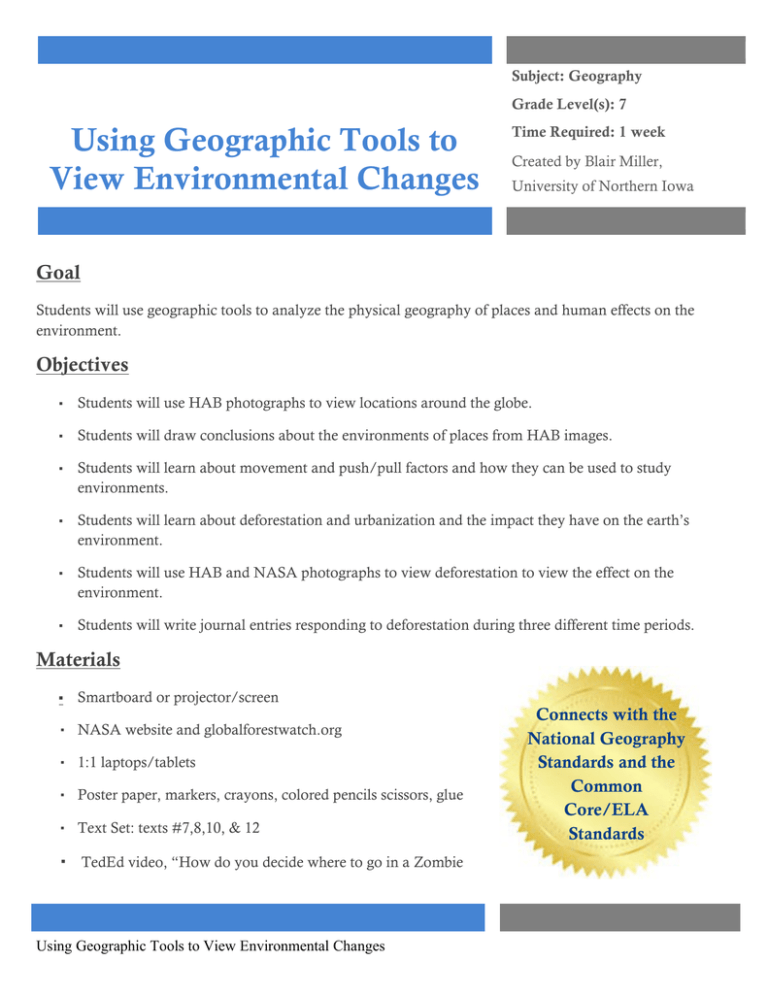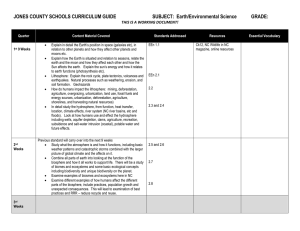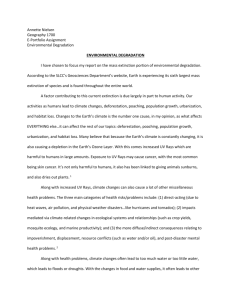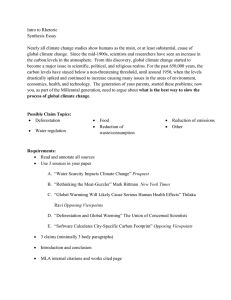Using Geographic Tools to View Environmental Changes
advertisement

Subject: Geography Grade Level(s): 7 Using Geographic Tools to View Environmental Changes Time Required: 1 week Created by Blair Miller, University of Northern Iowa Goal Students will use geographic tools to analyze the physical geography of places and human effects on the environment. Objectives ▪ Students will use HAB photographs to view locations around the globe. ▪ Students will draw conclusions about the environments of places from HAB images. ▪ Students will learn about movement and push/pull factors and how they can be used to study environments. ▪ Students will learn about deforestation and urbanization and the impact they have on the earth’s environment. ▪ Students will use HAB and NASA photographs to view deforestation to view the effect on the environment. ▪ Students will write journal entries responding to deforestation during three different time periods. Materials ▪ Smartboard or projector/screen ▪ NASA website and globalforestwatch.org ▪ 1:1 laptops/tablets ▪ Poster paper, markers, crayons, colored pencils scissors, glue ▪ Text Set: texts #7,8,10, & 12 ▪ TedEd video, “How do you decide where to go in a Zombie Using Geographic Tools to View Environmental Changes Connects with the National Geography Standards and the Common Core/ELA Standards Apocalypse?” ▪ Cause and effect chart for deforestation. Anticipatory Set During Class, Questions: ▪ Why would we analyze the connection between two locations even when there isn’t a zombie outbreak? ▪ How would you analyze movement to determine where to put a new sports stadium? ▪ What are reasons for human migration? ▪ What are push/pull factors of the location we live? Instructional Sequence/Procedure 1. DAY 1: Begin class by explaining how we can use HAB to view how Earth has changed over time and how it continues to change. We can use the images produced form HAB’s to view environmental changes and that is what we will be doing this week. 2. Next, show students the TedEd video, “How do you decide where to go in a zombie apocalypse?” Talk about the video and ask the students the four questions listed above. Lead discussion towards urbanization and have students formulate their own definition of urbanization. Ask students what factors urbanization affects (population, food, resources, land, etc.). 3. DAY 2: Give students Text #7 in the text set. Have them analyze it. What do they see? What can they infer from those two pictures? Experts predict the global population will top out around 10 billion people, with 7 billion of those people living in cities. What are some of the opportunities and challenges cities will face as the population increases? 4. Next, the students will create their own urbanization before and after poster. The teacher will provide each student with 1 poster board and markers, crayons, colored pencils, glue, and scissors. Each poster should represent a city before urbanization and after urbanization affected the city. 5. DAY 3: Ask students what they think deforestation is, where it is occurring, why it’s a problem. The teacher will then go to the NASA website and show student’s different pictures of deforestation so they get a visual of what it looks like from different views. 6. Next, give students Text #8. Teacher will facilitate a class discussion of the causes and effects of deforestation. The teacher will create a cause and effect chart on the board while the students write on their own cause and effect chart. Using Geographic Tools to View Environmental Changes 7. Student’s will then go to http://www.globalforestwatch.org/ (Teacher will have website on board, helping students navigate their way through the website). Students will go to Forest Change (pink) and the students can see globally the effects of deforestation. 8. DAY 4: Using Text #8, the students will create 3 journal entries of a person living on the East Coast. Each journal entry will correspond with each time period on Text #8. The student’s will describe the landscape/environment, resources around them (food, transportation, buildings, animals, etc). They will discuss the pros and cons of each thing as they write about it. 9. Volunteers will share their journal entries to the rest of the class when they are finished. If there are no volunteers, the teacher will call on people. 10. DAY 5: Students will read Text #12. As they read, the students are to mark anything that ties to the topic of urbanization and deforestation. 11. Next, the teacher will lead a group discussion of what they came up with and how these two topics correlate with each other. The teacher should fill in and discuss to the students anything they may have missed when reading the text. 12. Next, have students look at Text #10. What conclusions can they draw from this map? What inferences to urbanization and deforestation can they make? Why are maps important? Five Themes of Geography Used ▪ Location, Place, Region, Movement, Human-Environment Interaction Formative Evaluation ▪ Class discussions, class brainstorms, deforestation cause and effect chart. Assessment ▪ The students’ urbanization poster will be assessed for a grade. The other terms and concepts will be assessed on an end of the unit test. Common Core/ ELA Standards RH.6-8.7 Integrate visual information (e.g., in charts, graphs, photographs, videos, or maps) with other information in print and digital texts. Using Geographic Tools to View Environmental Changes National Geography Standards Standard 1: How to use maps and other geographic representations, tools, and technologies to acquire, process, and report information from a spatial perspective. Standard 3: How to analyze the spatial organization of people, places, and environments on Earth’s surface. Standard 4. The physical and human characteristics of places. 4 Standard 12. The processes, patterns, and functions of human settlement Standard 14. How human actions modify the physical environment Standard 18. How to apply geography to interpret the present and plan for the future Using Geographic Tools to View Environmental Changes Name: Date: Graphic Organizer: Cause and Effect T-Chart Topic: Cause(s) Effect(s) Creativewriting-prompts.com Graphic Organizer Cause and Effect T-Chart





